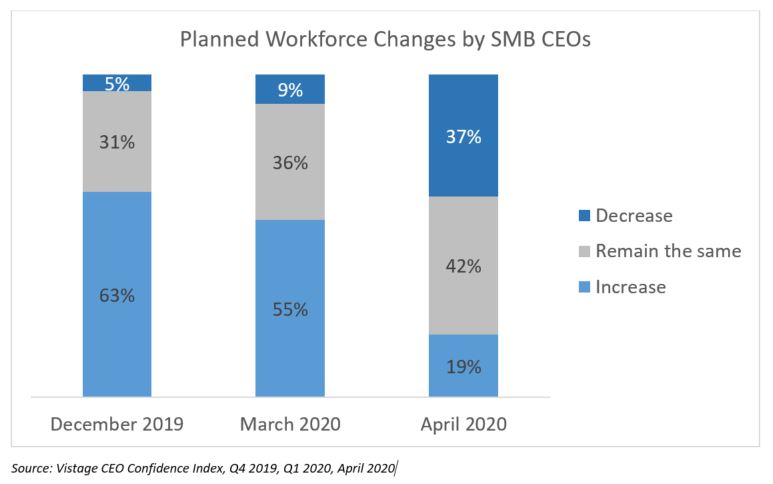Preparing for the other side of the pandemic: 5 considerations for HR

Just two months ago, business leaders were deeply engaged in building a strong culture — one that would retain top performers and attract new talent to help their companies grow. At the time, many small and midsize businesses (SMBs) were struggling to compete in the talent wars but eager to fulfill their hiring plans.
The COVID-19 pandemic has dramatically altered those plans. Between March and April, the percentage of SMB CEOs planning to expand their workforces fell from 55% to 19%, according to survey data from Vistage. (Of note, this percentage has likely declined further since the week of April 1-8, when the latest survey was administered.) Underscoring this point, the April Vistage CEO Confidence Index indicated that 37% of small businesses plan to decrease their workforces, which is 4.2 times higher than the previous month.

The survey data also indicated that working from home is a “new normal” for many businesses. In the April survey, 92% of CEOs said they had implemented remote working in the month prior, and 65% said they were considering remote working for the month ahead.
While adapting to this new reality, many leaders are starting to think about how to best manage their workforces when they reach the other side of the pandemic. Hunter Lott, Vistage speaker and human resources expert, shares five key considerations to help business leaders and HR teams prepare for what’s next.
#1. Workplace: Planning for permanent or periodic work-from-home
In the past month, social distancing protocols have forced companies to quickly adapt to remote working. For HR teams, this has meant developing work-from-home policies, providing appropriate technology, establishing communication channels, and introducing methods to ensure accountability and productivity.

Going forward, many businesses will make work from home a permanent reality. Others will try to return to the office in some capacity. For the latter, HR teams should start making preparations now. “Are you just going to turn the lights on one day again and everybody shows up?” says Lott. “No. It’s probably going to be phased in.”
Until a COVID-19 vaccine is developed in the next 12-18 months, companies should anticipate periodic enforcements of social distancing and plan accordingly. Key considerations include job descriptions, office/conference spaces and whether work can be performed remotely.
#2. Communication: Reaching out regularly and often
Leaders should touch base with employees frequently to set expectations, acknowledge good work and reinforce messages about the company’s purpose. If leaders don’t communicate this information, employees are likely to draw their own conclusions. “They will assume the worst, especially in a stressful situation,” says Lott.
It’s important to establish a communication routine. For example, many companies find it useful to host daily meetings where leaders share the latest updates. Following these meetings, managers should individually reach out to their employees. Ask them, “What did you hear? What questions do you have? What are you working on? How can I help?” says Lott.
#3. Brand: Telling your story
Furloughs and layoffs have weakened the brands of many companies. To start rebuilding that brand, “tell your story” on the company website, says Lott. “Start with employees saying what a great place it is to work. Video testimonials work great as well, helping you showcase the ‘quiet heroes.’”
Building a strong brand isn’t just about attracting customers. It’s also about attracting top talent. Once a company is ready to bring back top performers — either ones they’ve furloughed or ones they want to recruit — they’ll need a strong brand that resonates with them.
#4. Talent: Attracting “A-players”
It’s been said that culture and brand are two sides of the same coin. Culture is essentially a company’s HR brand. If leaders realize their culture is not what it needs to be, now is a good time to determine what’s working and what’s not.
To start this process, Lott recommends talking to A-players to find out why they’re here. Ask them, “What are we doing right? What are we doing wrong?” Based on this information, companies can develop tactics to attract other A-players. This is especially useful for companies that have to build a new culture from scratch.
To “hire fast,” look at the best employees in various positions and identify what makes them top performers. This will help guide the interviewing process and guard against missed opportunities. “Be so well-prepared that you know the job description, the performance and the behavior blend that works — so if you find it, you can make an offer,” Lott says.
#5. Decision-making: Eliminating toxic employees
There is nothing more damaging to culture than toxic employees. To identify them, leaders should compare the performance and behavior of every employee to the values of the company.
Leaders should also consider how good and bad behaviors might manifest differently in remote-working situations. For example, employees might start to “get nasty” in emails or online chats, says Lott. It’s also a good idea to ask managers, “Knowing what you know now about this employee, would you enthusiastically rehire them? If not, why not?” This input should inform hiring or firing decisions now and into the future.
Category: Talent Management
Tags: Challenging Times Business Strategies, coronavirus, Expert Speakers, Human Resources, talent, webinar on demand

